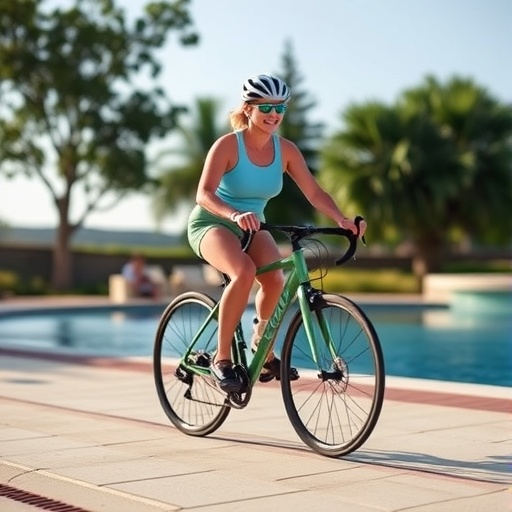In a groundbreaking synthesis of research published recently in The BMJ, a comprehensive systematic review and network meta-analysis has revealed that aerobic exercise emerges as the most effective and safest modality for alleviating the debilitating symptoms of knee osteoarthritis (OA). This extensive study analyzed 217 randomized controlled trials conducted over three decades, encompassing data from more than 15,000 participants—marking the most robust evaluation of exercise interventions for knee OA to date.
Knee osteoarthritis is a chronic joint condition characterized by the progressive degradation of cartilage, the protective layer cushioning the bones in the knee joint. As cartilage deteriorates, patients experience pain, inflammation, swelling, and a consequent decline in mobility and quality of life. Affecting nearly 30% of adults over 45 according to radiographic evidence, knee OA represents a significant source of disability globally, with many individuals enduring severe symptoms that profoundly impair their daily activities.
While the therapeutic value of physical activity in managing OA has long been recognized, previous clinical guidelines offered limited specificity regarding the types of exercise best suited for treating knee OA. This knowledge gap prompted researchers to meticulously evaluate the comparative benefits and safety profiles of various exercise regimens, including aerobic, flexibility, strength training, mind-body practices, neuromotor training, and mixed modalities.
The review employed the GRADE system, a rigorous framework for assessing the quality and certainty of evidence, to critically appraise the amassed trial data. Key outcome measures were delineated as pain relief, functional improvement, gait performance, and quality of life enhancements, with assessments conducted across short-term (four weeks), medium-term (12 weeks), and long-term (24 weeks) intervals to capture both immediate and sustained effects of the interventions.
Aerobic exercise consistently demonstrated superior efficacy across multiple domains. Moderate-certainty evidence revealed that engaging in aerobic activities such as walking, cycling, or swimming significantly mitigated pain during both short and mid-term follow-up periods. Moreover, these activities facilitated improvement not only in function shortly after initiation but also maintained these gains through medium and long-term evaluations, highlighting their role in fostering sustained joint health and mobility.
Beyond pain and physical function, aerobic exercise also delivered pronounced benefits in enhancing gait performance—a critical factor in daily ambulation and fall prevention—as well as quality of life indices measured during short and medium-term follow-ups. These findings underscore the multifaceted advantages of aerobic conditioning, extending beyond mere symptom control to improving patients’ overall well-being and independence.
The study also illuminated the notable benefits of other exercise modalities, albeit as complementary strategies rather than primary treatments. Mind-body exercises, typified by practices like Tai Chi and yoga, were linked with substantial improvements in short-term functional capacity. Neuromotor exercises, aimed at refining coordination and balance, showed promise in augmenting gait mechanics in the short term. Strengthening and mixed exercise programs appeared particularly beneficial in boosting functional capacity by mid-term assessments, suggesting their utility in longer rehabilitation courses.
Importantly, the rigorous safety analysis dispelled concerns about increased adverse events with any exercise form. None of the activity categories studied led to a higher incidence of complications compared to control groups, establishing exercise therapy as a safe cornerstone in the therapeutic armamentarium for knee OA. This safety profile is crucial for clinicians designing patient-specific interventions, emphasizing that the risks of physical activity are minimal when appropriately supervised and tailored.
The authors acknowledge certain limitations within their review methodology. Many conclusions derive from indirect comparisons, reflecting variability in direct head-to-head trial data across exercise types. Additionally, long-term outcome data were sparse for several modalities, and early trial results might be influenced by small-sample biases. Despite these caveats, the synthesis presents the most comprehensive and current understanding of exercise efficacy and safety in knee OA management.
Clinically, these findings advocate for aerobic exercise as the primary intervention recommended for knee OA treatment, especially when the therapeutic objectives include enhancing patients’ functional capacity and reducing pain. Aerobic exercise’s broad-spectrum benefits and verified safety endorse its prioritization in clinical practice guidelines and patient education.
For patients unable to engage in aerobic activities due to comorbidities or physical limitations, alternative structured physical activity regimens like mind-body or neuromotor exercises should be considered. These modalities remain valuable options capable of delivering meaningful improvements and can be integrated into multidisciplinary management plans.
This landmark meta-analysis not only informs therapeutic decision-making but also calls for future research to close existing knowledge gaps, particularly focusing on long-term effectiveness and refining individualized exercise prescriptions. The comprehensive evidence base provided serves as an essential resource for healthcare providers seeking to optimize functional outcomes and quality of life for patients grappling with knee osteoarthritis worldwide.
Subject of Research:
People
Article Title:
Comparative efficacy and safety of exercise modalities in knee osteoarthritis: systematic review and network meta-analysis
News Publication Date:
15-Oct-2025
Web References:
http://dx.doi.org/10.1136/bmj-2025-085242
Keywords:
Osteoarthritis, Physical exercise, Knee osteoarthritis, Aerobic exercise, Exercise therapy, Pain management, Joint function, Gait performance, Quality of life
Tags: aerobic exercise for knee painbenefits of walking for knee healthbest exercises for knee OAchronic joint pain management strategiescycling as therapy for knee OAimproving mobility with knee OAknee osteoarthritis exercise effectivenessmanaging knee osteoarthritis symptomsphysical activity guidelines for osteoarthritisrehabilitation exercises for knee osteoarthritisswimming exercises for joint painsystematic review on knee osteoarthritis





